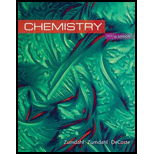
Concept explainers
(a)
Interpretation: The molecular structure of the given molecules is to be determined.
Concept introduction: The molecular structure is the representation of the molecule that defines the exact position of the atom in a molecule.
To determine: The molecular structure of
(b)
Interpretation: The molecular structure of the given molecules is to be determined.
Concept introduction: The molecular structure is the representation of the molecule that defines the exact position of the atom in a molecule.
To determine: The molecular structure of
(c)
Interpretation: The molecular structure of the given molecules is to be determined.
Concept introduction: The molecular structure is the representation of the molecule that defines the exact position of the atom in a molecule.
To determine: The molecular structure of
(d)
Interpretation: The molecular structure of the given molecules is to be determined.
Concept introduction: The molecular structure is the representation of the molecule that defines the exact position of the atom in a molecule.
To determine: The molecular structure of
Trending nowThis is a popular solution!

Chapter 20 Solutions
Chemistry
- A Lewis structure obeying the octet rule can be drawn for O2 as follows: Use the molecular orbital energy-level diagram for O2 to show that the above Lewis structure corresponds to an excited state.arrow_forwardConsider the following Lewis structure where E is an unknown element: What are some possible identities for element E? Predict the molecular structure (including bond angles) for this ion.arrow_forwardBond Enthalpy When atoms of the hypothetical element X are placed together, they rapidly undergo reaction to form the X2 molecule: X(g)+X(g)X2(g) a Would you predict that this reaction is exothermic or endothermic? Explain. b Is the bond enthalpy of X2 a positive or a negative quantity? Why? c Suppose H for the reaction is 500 kJ/mol. Estimate the bond enthalpy of the X2 molecule. d Another hypothetical molecular compound, Y2(g), has a bond enthalpy of 750 kJ/mol, and the molecular compound XY(g) has a bond enthalpy of 1500 kJ/mol. Using bond enthalpy information, calculate H for the following reaction. X2(g)+Y2(g)2XY(g) e Given the following information, as well as the information previously presented, predict whether or not the hypothetical ionic compound AX is likely to form. In this compound, A forms the A+ cation, and X forms the X anion. Be sure to justify your answer. Reaction: A(g)+12X2(g)AX(s)The first ionization energy of A(g) is 400 kJ/mol. The electron affinity of X(g) is 525 kJ/mol. The lattice energy of AX(s) is 100 kJ/mol. f If you predicted that no ionic compound would form from the reaction in Part e, what minimum amount of AX(s) lattice energy might lead to compound formation?arrow_forward
- Write the Lewis structure for the diatomic molecule P2, an unstable form of phosphorus found in high temperature phosphorus vapor.arrow_forwardAlthough PF5 and ASF5 are stable, nitrogen does not form NF5 molecules. Explain this difference among members of the same group.arrow_forwardThe compound NF3 is quite stable, but NCl3 is very unstable (NCl3 was first synthesized in 1811 by P. L. Dulong, who lost three fingers and an eye studying its properties). The compounds NBr3 and NI3 are unknown, although the explosive compound NI3 NH3 is known. Account for the instability of these halides of nitrogen.arrow_forward
- The standard enthalpy of formation for NO(g) is 90. kJ/mol. Use this and the values for the O 9 O and N N bond energies to estimate the bond strength in NO.arrow_forwardConsider the compound xenon dichloride, XeCl2 a.What is the polarity of the molecule? b. What type of bond is the Xe-Cl bond? c. How many bonding pairs of electrons are there?arrow_forwardThe bond energy of N2 is 160 kJ/mol. What is the wavelength of a photon that can cause the dissociation of a N2 molecule? (h = 6.63 × 10–34J s; c = 3.0 × 108m/s and Avogadro's number = 6.022 × 1023 molecules/mole)arrow_forward
- What is the molecular structure for each of the following molecules or ions? a. OCl2 b. ClO4- c. ICl5 d. PF6-4.arrow_forwardConsider selenium oxychloride (SeOCl2): What is the electron geometry of this molecule? What is the molecular shape of this molecule?arrow_forwardGroup 2 elements have two valence electrons. Which kind of bond will they most likely form, and why? * A:An ionic bond is likely because they will want to give away two valence electrons in order to become stable. B:A metallic bond is likely because they are metals and can bond with other metals. C:A covalent bond is likely because they want to share those two valence electrons in order to become stable. D:An ionic bond is likely because they are metals and will want to bond with nonmetals.arrow_forward
 ChemistryChemistryISBN:9781305957404Author:Steven S. Zumdahl, Susan A. Zumdahl, Donald J. DeCostePublisher:Cengage Learning
ChemistryChemistryISBN:9781305957404Author:Steven S. Zumdahl, Susan A. Zumdahl, Donald J. DeCostePublisher:Cengage Learning
 Chemistry: An Atoms First ApproachChemistryISBN:9781305079243Author:Steven S. Zumdahl, Susan A. ZumdahlPublisher:Cengage Learning
Chemistry: An Atoms First ApproachChemistryISBN:9781305079243Author:Steven S. Zumdahl, Susan A. ZumdahlPublisher:Cengage Learning Chemistry by OpenStax (2015-05-04)ChemistryISBN:9781938168390Author:Klaus Theopold, Richard H Langley, Paul Flowers, William R. Robinson, Mark BlaserPublisher:OpenStax
Chemistry by OpenStax (2015-05-04)ChemistryISBN:9781938168390Author:Klaus Theopold, Richard H Langley, Paul Flowers, William R. Robinson, Mark BlaserPublisher:OpenStax General Chemistry - Standalone book (MindTap Cour...ChemistryISBN:9781305580343Author:Steven D. Gammon, Ebbing, Darrell Ebbing, Steven D., Darrell; Gammon, Darrell Ebbing; Steven D. Gammon, Darrell D.; Gammon, Ebbing; Steven D. Gammon; DarrellPublisher:Cengage Learning
General Chemistry - Standalone book (MindTap Cour...ChemistryISBN:9781305580343Author:Steven D. Gammon, Ebbing, Darrell Ebbing, Steven D., Darrell; Gammon, Darrell Ebbing; Steven D. Gammon, Darrell D.; Gammon, Ebbing; Steven D. Gammon; DarrellPublisher:Cengage Learning




